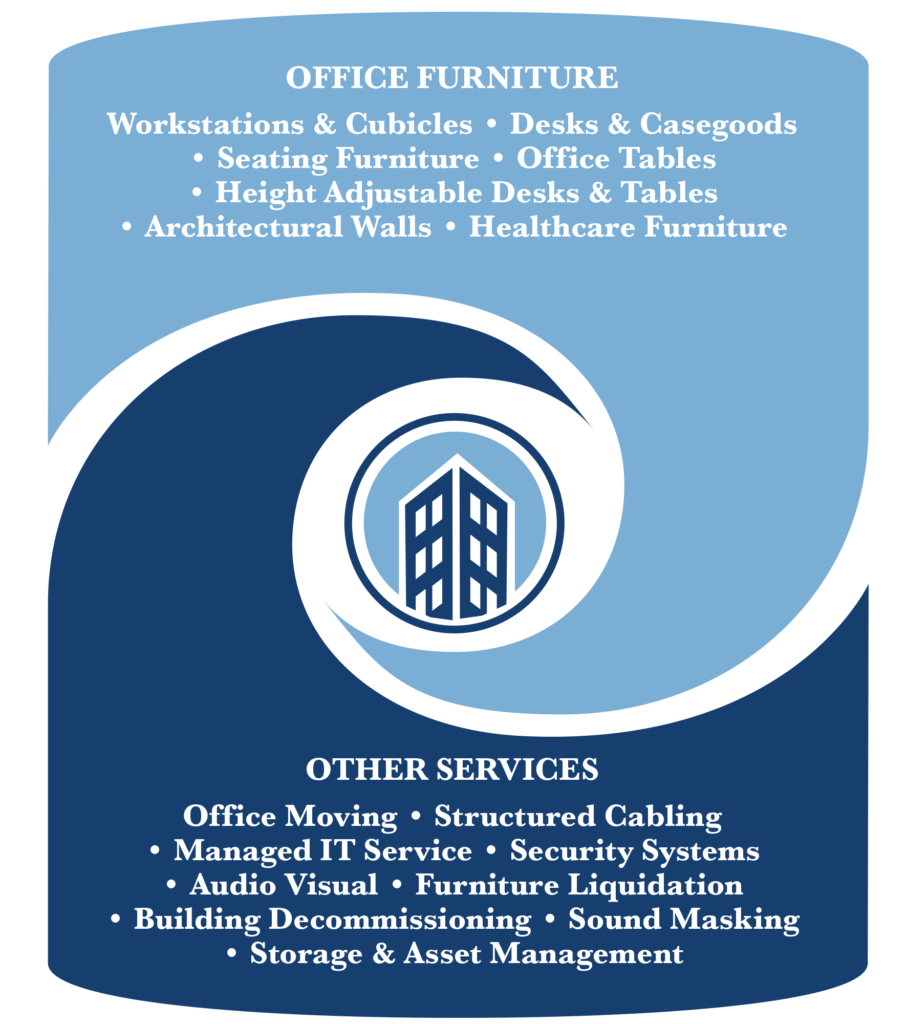21 Mar Modern Office Space Made Easy with Smart Furniture Choices
The landscape of modern office design has undergone a remarkable transformation over the past few decades. Gone are the days of drab, uniform cubicles that once dominated corporate environments. Today’s workplaces are evolving into dynamic, flexible spaces that prioritize employee well-being, collaboration, and productivity.
This shift began in the late 20th century when companies started recognizing the impact of work environments on employee satisfaction and output. The rigid cubicle layouts, while efficient in maximizing floor space, challenged creativity and morale. As a result, organizations began experimenting with open floor plans, which promised improved communication and teamwork.
However, the pendulum soon swung too far in the opposite direction. While open offices facilitated interaction, they also introduced new challenges such as noise pollution and lack of privacy. This realization has led to the current trend of hybrid designs – spaces that balance openness with areas for focused work and private conversations. The modern office now incorporates a variety of zones, each tailored to different work styles and tasks, reflecting a more nuanced understanding of productivity and employee needs.
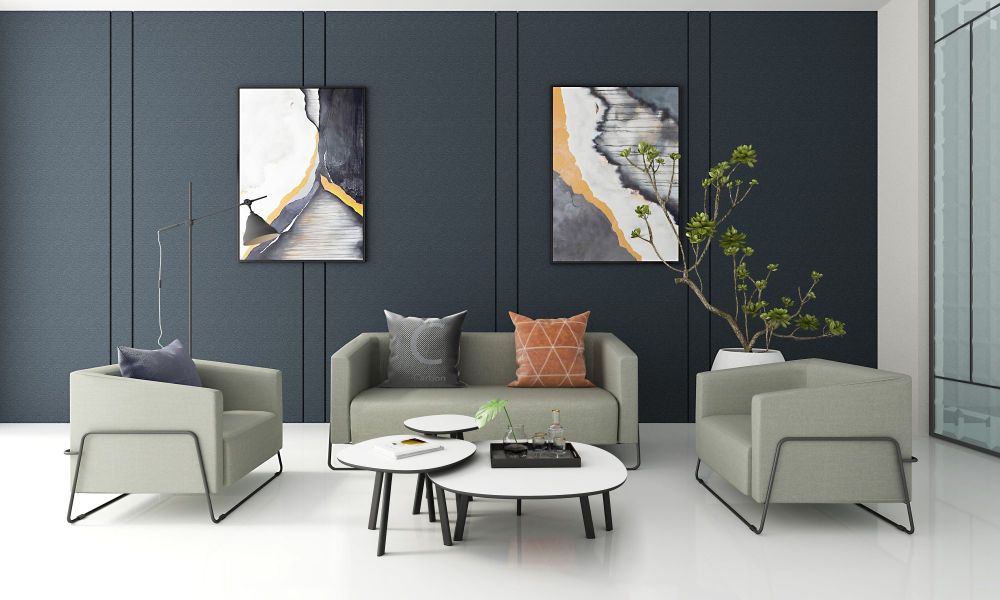
Imagery Sources: 9to5, Global Furniture Group, Friant
Understanding the Impact of Office Furniture on Productivity and Well-being
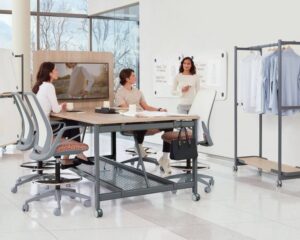 The furniture you choose for your office plays a crucial role in shaping the work experience of your employees. Well-designed, ergonomic furniture can significantly boost productivity, reduce physical strain, and contribute to overall job satisfaction. On the other hand, poorly chosen pieces can lead to discomfort, decreased efficiency, and even long-term health issues.
The furniture you choose for your office plays a crucial role in shaping the work experience of your employees. Well-designed, ergonomic furniture can significantly boost productivity, reduce physical strain, and contribute to overall job satisfaction. On the other hand, poorly chosen pieces can lead to discomfort, decreased efficiency, and even long-term health issues.
Consider the average office worker who spends approximately 40 hours a week at their desk. The chair they sit in, the desk they work at, and the lighting they’re exposed to all have a direct impact on their posture, comfort, and ability to focus. Ergonomically designed furniture supports proper body alignment, reducing the risk of musculoskeletal problems and fatigue. This, in turn, allows employees to maintain concentration for longer periods and produce higher quality work.
Moreover, the aesthetic appeal of office furniture shouldn’t be underestimated. A well-designed workspace can inspire creativity, foster a sense of pride in the company, and even aid in attracting and retaining top talent. When employees feel valued and comfortable in their environment, they’re more likely to be engaged and motivated. Thus, investing in quality office furniture is not just about physical comfort – it’s about creating an atmosphere that promotes well-being, productivity, and positive company culture.
Key Furniture Pieces and Design Choices for a Modern Office Makeover
The following summary of furniture and design choices is offered from the experience of Mac MacCardle, MyOffice’s Director of Design & Furniture/Director of Sales. With over 40 years of office space outfitting, his insights are invaluable for his numerous current and former clients.
Ergonomic Chairs: The Foundation of Comfort and Efficiency
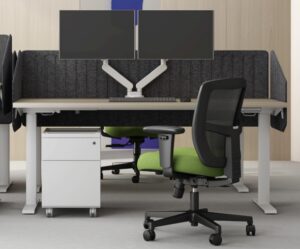 At the heart of any productive workspace lies the humble office chair. However, in modern office design, these are far from ordinary seats. Ergonomic chairs have become the gold standard, offering a range of adjustable features to accommodate various body types and working styles.
At the heart of any productive workspace lies the humble office chair. However, in modern office design, these are far from ordinary seats. Ergonomic chairs have become the gold standard, offering a range of adjustable features to accommodate various body types and working styles.
Look for chairs with adjustable lumbar support, seat height, and armrests. These features allow users to customize their seating position, promoting proper posture and reducing the risk of back pain. Some advanced models even offer dynamic support that adapts to the user’s movements throughout the day.
Investing in high-quality ergonomic chairs may seem costly upfront, but the long-term benefits far outweigh the initial expense. Reduced absenteeism due to back problems, increased productivity, and improved employee satisfaction are just a few of the advantages you can expect. Remember, a comfortable employee is a focused employee, and ergonomic chairs are the foundation of workplace comfort.
Versatile Desks: From Standing Desks to Collaborative Workstations
The modern office desk has evolved far beyond the traditional fixed workspace. Today’s desks accommodate various working styles and promote movement throughout the day. Standing desks and sit-stand desks have gained popularity for their health benefits and ability to combat the negative effects of prolonged sitting.
These adjustable desks allow employees to alternate between sitting and standing positions, promoting better circulation, and reducing the risk of obesity, diabetes, and cardiovascular disease. Many models offer electric height adjustment, making it easy for users to find their ideal working position at the touch of a button.
For collaborative spaces, consider modular desks that can be easily reconfigured to accommodate different team sizes and project needs. These flexible solutions allow you to adapt your office layout quickly and efficiently as your organization’s needs change. Some desks even come with built-in power outlets and cable management systems, keeping your workspace tidy and functional.
Storage Solutions: Balancing Organization and Aesthetics
In the age of digital transformation, you might think that physical storage solutions are becoming obsolete. However, smart storage remains a crucial element in modern office design. The key is to find storage options that balance functionality with aesthetics, contributing to a clean and organized workspace without sacrificing style.
Consider sleek, modular storage units customized to fit your specific needs. Wall-mounted shelves and cabinets can maximize vertical space, keeping the floor area open and uncluttered. For a more flexible approach, mobile storage units on wheels allow for easy reconfiguration of the office layout.
Don’t forget about personal storage for employees. Lockers or personal drawers provide a sense of ownership and privacy, even in open office layouts. Look for solutions that integrate seamlessly with your overall office design, using materials and finishes that complement your aesthetic while serving a practical purpose.
Breakout Areas: Creating Spaces for Relaxation and Informal Meetings
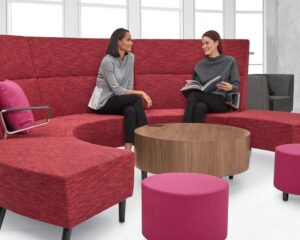 The importance of breakout areas in modern offices cannot be overstated. These spaces serve multiple purposes: they provide a change of scenery for employees needing a break from their desks, facilitate informal meetings and brainstorming sessions, and contribute to a more relaxed and creative office atmosphere.
The importance of breakout areas in modern offices cannot be overstated. These spaces serve multiple purposes: they provide a change of scenery for employees needing a break from their desks, facilitate informal meetings and brainstorming sessions, and contribute to a more relaxed and creative office atmosphere.
When designing breakout areas, focus on comfort and versatility. Soft seating options like lounge chairs, sofas, and bean bags create a casual environment that encourages relaxation and open communication. Include a variety of seating arrangements to accommodate both individual work and small group discussions.
Consider incorporating elements that stimulate creativity and engagement. Writable surfaces like whiteboards or glass panels can turn any wall into a brainstorming tool. Adding games or recreational activities can help employees decompress and foster team bonding. Remember, the goal is to create a space that feels distinctly different from the main work area, providing a true ‘break’ from the daily grind.
Lighting: Illuminating Productivity and Mood
Proper lighting is often an overlooked aspect of office design, yet it plays a crucial role in employee well-being and productivity. Poor lighting can lead to eye strain, headaches, and decreased focus, while well-designed lighting can boost mood, energy levels, and overall work performance.
Start by maximizing natural light wherever possible. Position desks and workstations near windows to take advantage of daylight. For areas where natural light is limited, consider installing skylights or light tubes to bring in more sunshine.
Complement natural light with a layered artificial lighting approach:
- Ambient lighting: Provides overall illumination for the space.
- Task lighting: Focused light for specific work areas.
- Accent lighting: Highlights architectural features or artwork.
Invest in adjustable desk lamps that allow employees to control their immediate lighting environment. LED bulbs with color temperature adjustment can mimic natural daylight, helping to regulate circadian rhythms and improve sleep quality.
Biophilic Design: Incorporating Nature into the Office
Biophilic design, which seeks to connect building occupants more closely to nature, has gained significant traction in modern office design. This approach not only enhances the aesthetic appeal of the workspace but also offers numerous benefits for employee well-being and productivity.
Incorporate natural elements into your office design through:
- Living walls or vertical gardens
- Indoor plants of various sizes
- Natural materials like wood and stone
- Water features for a calming effect
- Nature-inspired artwork and patterns
Studies have shown that biophilic design elements can reduce stress, improve cognitive function, and enhance creativity. Even small additions like desktop plants or nature-themed wall coverings can make a significant impact on the overall feel of your office space.
Technology Integration: Furniture that Supports Digital Workflows
In today’s digital-first work environment, office furniture must do more than just provide a place to sit or store items. Modern office furniture should seamlessly integrate with and support the technology that drives our daily workflows.
Look for desks and tables with built-in power outlets and USB charging ports to keep devices powered throughout the day. Cable management solutions are essential for maintaining a clean, professional look while ensuring easy access to necessary connections.
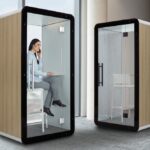 Consider furniture designed specifically for video conferencing. Privacy pods that provide acoustic privacy and proper lighting for virtual meetings are an excellent choice. Collaborative spaces equipped with large displays or interactive whiteboards facilitate digital presentations and remote team collaboration.
Consider furniture designed specifically for video conferencing. Privacy pods that provide acoustic privacy and proper lighting for virtual meetings are an excellent choice. Collaborative spaces equipped with large displays or interactive whiteboards facilitate digital presentations and remote team collaboration.
Smart furniture is also on the rise, with options like desks that remind users to stand periodically or chairs that track sitting time and posture. While these high-tech solutions may not be necessary for every office, they represent the growing trend of furniture that actively contributes to employee well-being and productivity.
Budget-Friendly Tips for Modernizing Your Office Space
Revitalizing your office doesn’t always require a complete overhaul or a hefty budget. Here are some cost-effective strategies to modernize your workspace:
- Prioritize key pieces: Focus on upgrading the most impactful items first, such as ergonomic chairs and adjustable desks.
- Repurpose existing furniture: Give old pieces new life with a fresh coat of paint or new hardware.
- Opt for modular solutions: Choose furniture that can be easily reconfigured or expanded as your needs change.
- Embrace minimalism: A clean, uncluttered space can feel modern without requiring expensive furniture.
- DIY where possible: Create custom storage solutions or decorative elements to add personality without breaking the bank.
- Shop second-hand: Look for high-quality used furniture from office liquidators or online marketplaces.
- Invest in multi-functional pieces: Choose furniture that serves multiple purposes to maximize your budget.
- Focus on lighting: Upgrading your lighting can dramatically improve the feel of your office at a relatively low cost.
- Add plants: Incorporating greenery is an affordable way to embrace biophilic design and improve air quality.
- Create zones with rugs and partitions: Define different areas of your office without structural changes using area rugs and movable partitions.
Remember, modernizing your office is about creating a more functional, comfortable, and inspiring environment for your employees. Even small changes can have a significant impact on productivity and morale.
Concluding Thoughts: The Future of Modern Office Design: Trends to Watch
As we look ahead, several emerging trends are shaping the future of office design:
- Flexibility and Adaptability: The ability to quickly reconfigure spaces for different needs will become increasingly important.
- Hybrid Work Support: Offices will need to accommodate a mix of in-person and remote workers, with enhanced technology for seamless collaboration.
- Wellness-Focused Design: Expect to see more features that promote physical and mental health, from air purification systems to meditation spaces.
- Sustainable Materials: Eco-friendly furniture and finishes will become the norm as companies prioritize environmental responsibility.
- Smart Office Technology: IoT-enabled furniture and spaces will provide data on usage patterns and environmental conditions, allowing for optimized office management.
- Residential-Inspired Comfort: Office design will continue to borrow elements from home interiors to create more comfortable, inviting workspaces.
- Biophilic Design Evolution: The integration of nature into office spaces will become more sophisticated, potentially including indoor gardens or even office farms.
- Acoustic Design: As open plans evolve, there will be a greater focus on managing sound and creating quiet zones for focused work.
- Virtual and Augmented Reality: These technologies offer everything from virtual office tours to enhanced remote collaboration.
- Personalization: Furniture and spaces that can adapt to individual preferences will become more prevalent, potentially using AI to learn and anticipate user needs.
As you consider modernizing your office space, keep these trends in mind. While not every trend will be suitable for every workplace, staying informed about these developments can help you make forward-thinking decisions that will serve your organization well into the future.
Ready to transform your office into a modern, productive workspace? Start by assessing your current setup and identifying areas for improvement. Consider scheduling a consultation with an office design expert who can help you create a tailored plan that fits your budget and aligns with your company’s culture and goals. Remember, investing in your office environment is an investment in your employees’ well-being and your organization’s success. Take the first step towards a revitalized workplace today – your team will thank you for it!
Contact us today to schedule a consultation and discover how we can help you create the modern office space that not only meets but exceeds your employees’ expectations.
MyOffice has over 20 years of experience in supporting client’s implementing office solutions. We understand the needs of the modern office environment. Optimizing your workspace through furniture selection and layout is a core competency of ours. We are here to help!
